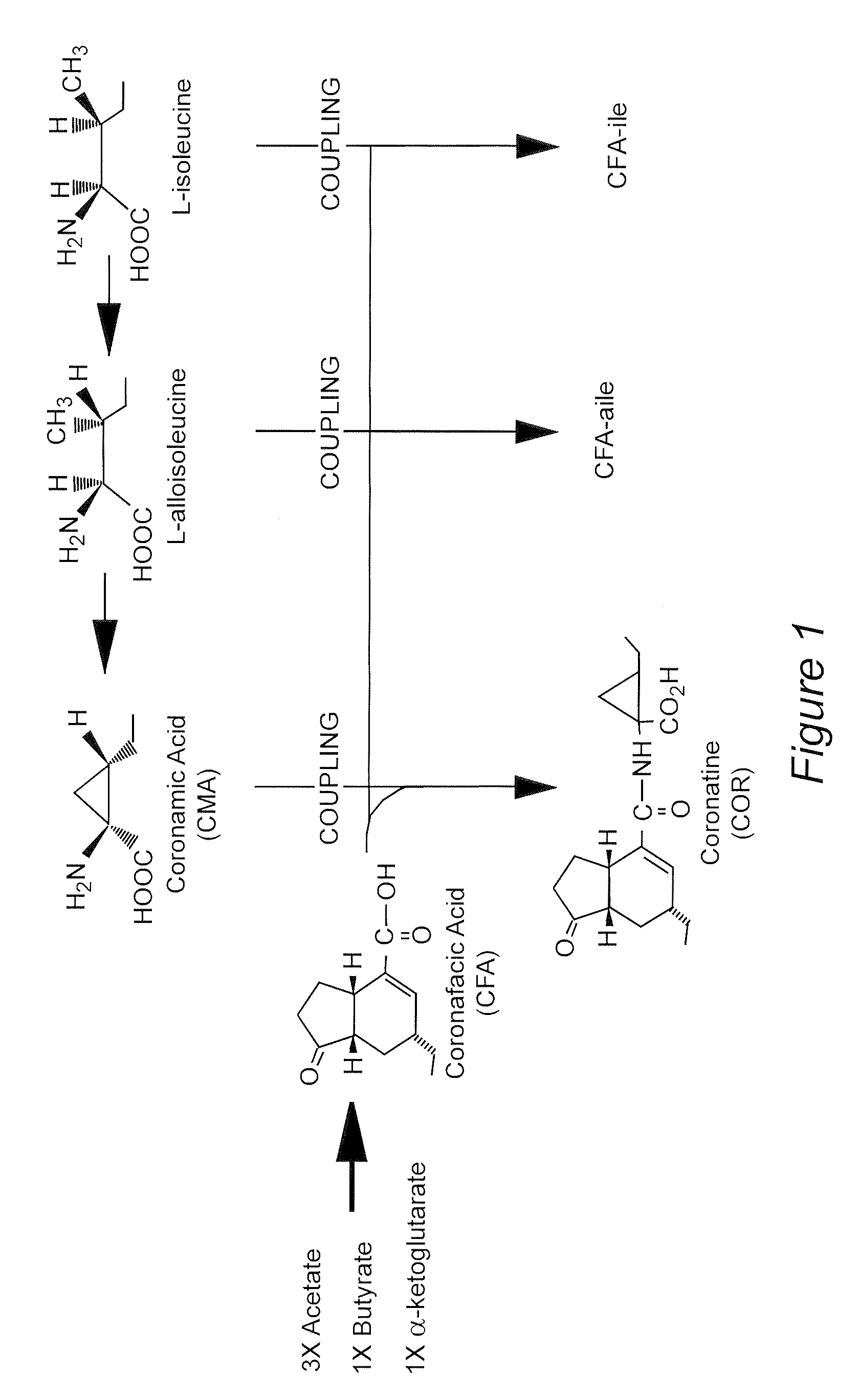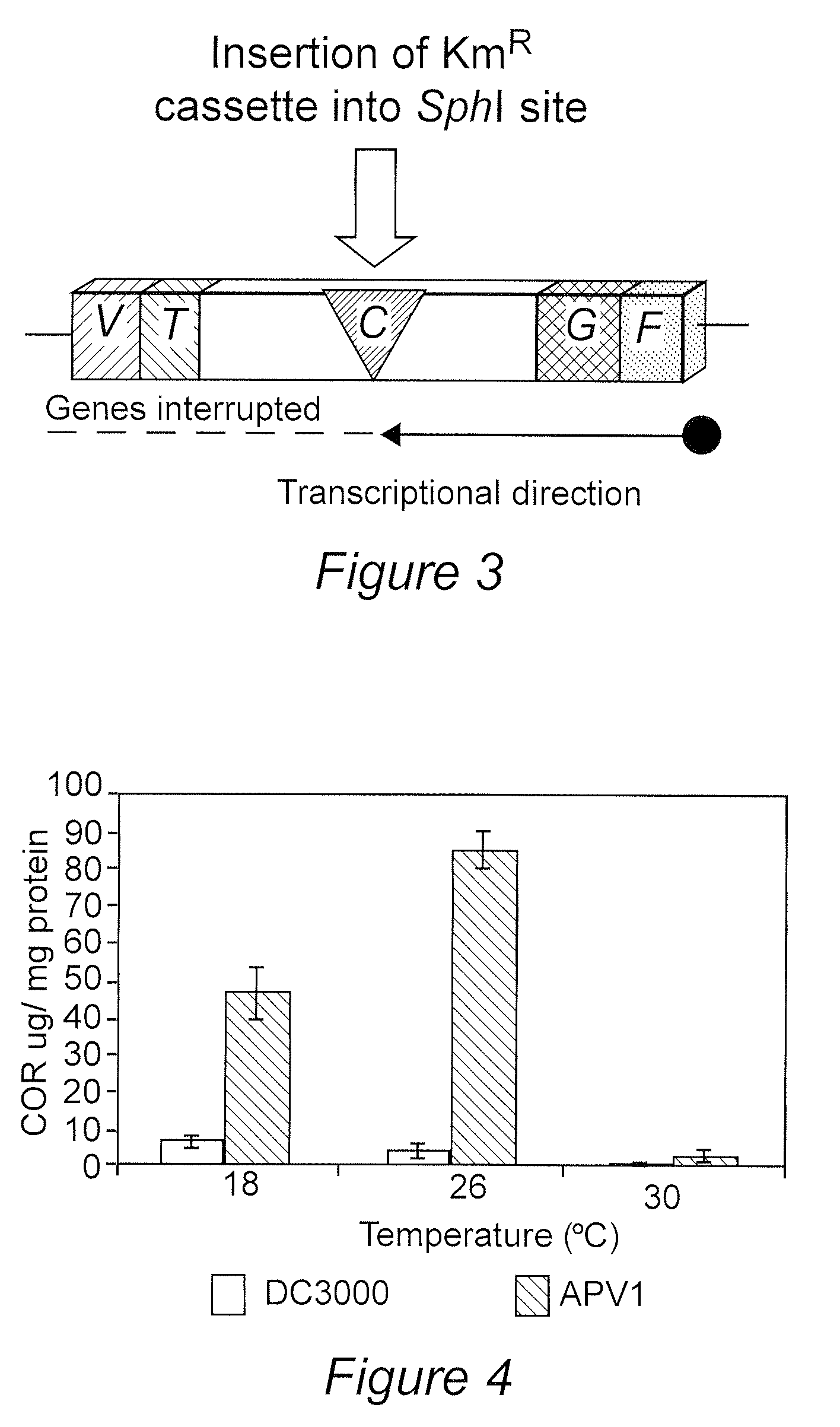Optimization of Coronatine Production in a Genetically Improved Strain of Pseudomonas Syringae
- Summary
- Abstract
- Description
- Claims
- Application Information
AI Technical Summary
Benefits of technology
Problems solved by technology
Method used
Image
Examples
example 1
REFERENCES FOR EXAMPLE 1
[0086]Alexeyev, M. F. (1995) Three kanamycin resistance gene cassettes with different polylinkers. BioTechniques 18: 52-55.[0087]Bender, C. L., Young, S. A., and Mitchell, R. E. (1991) Conservation of plasmid DNA sequences in coronatine-producing pathovars of Pseudomonas syringae. Appl. Environ. Microbiol. 57: 993-999.[0088]Burns, J. K., Pozo, L. V., Arias, C.R., Hockema, B., Rangaswamy, V., and Bender, C. L. 2003. Coronatine and abscission in citrus. J. Amer. Soc. Hort. Sci. 128: 309-315.[0089]Ferguson, I., and Mitchell, R. (1985) Stimulation of ethylene production in bean leaf discs by the Pseudomonad phytotoxin coronatine. Plant Physiol. 77: 969-973.[0090]Feys, B., Penfold, C. and Turner, J. (1994) Arabidopsis mutants selected for resistance to the phytotoxin coronatine are male sterile, insensitive to methyl jasmonate, and resistant to a bacterial phytotoxin. Plant Cell 6: 751-759.[0091]Hirano, S. S., Charkowski, A. O., Collmer, A., Willis, D. K., and Upp...
example 2
REFERENCES FOR EXAMPLE 2
[0110]Bae, H. S., Lee, J. M., and Lee, S. T. (1997) Biodegradation of the mixture of 2,4,6-trichlorophenol, 4-chlorophenol, and phenol by a defined mixed culture. J. Gen. Appl. Microbiol. 43: 97-103.[0111]Banerjee, A., Kaul, P., and Banerjee, U. C. (2006) Enhancing the catalytic potential of nitrilase from Pseudomonas putida for stereoselective nitrile hydrolysis. Appl. Microbiol. Biotechnol. 72:77-87.[0112]Bender, C. L., Alarcon-Chaidez, F., and Gross, D.C. (1999) Pseudomonas syringae phytotoxins: mode of action, regulation, and biosynthesis by peptide and polyketide synthetases. Microbiol. Mol. Biol. Rev. 63: 266-292.[0113]Brodelius, P., and K. Mosbach. (1987) Overview of immobilization techniques for cells / organelles. Meth. Enzymol. 135:173-175.[0114]Bucke, C. 1987. Cell immobilization in calcium alginate. In Immobilization Techniques for cells / organelles. Meth. Enzymol. 135:175-189.[0115]Burns, J. K. (2002) Using molecular biology tools to identify abscis...
PUM
| Property | Measurement | Unit |
|---|---|---|
| Temperature | aaaaa | aaaaa |
| Temperature | aaaaa | aaaaa |
| Temperature | aaaaa | aaaaa |
Abstract
Description
Claims
Application Information
 Login to View More
Login to View More - R&D
- Intellectual Property
- Life Sciences
- Materials
- Tech Scout
- Unparalleled Data Quality
- Higher Quality Content
- 60% Fewer Hallucinations
Browse by: Latest US Patents, China's latest patents, Technical Efficacy Thesaurus, Application Domain, Technology Topic, Popular Technical Reports.
© 2025 PatSnap. All rights reserved.Legal|Privacy policy|Modern Slavery Act Transparency Statement|Sitemap|About US| Contact US: help@patsnap.com



